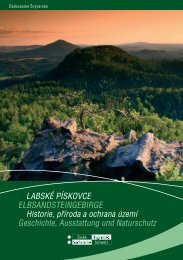ABSTRACT BOOK Sandstone Landscapes ... - Sandstones.org
ABSTRACT BOOK Sandstone Landscapes ... - Sandstones.org
ABSTRACT BOOK Sandstone Landscapes ... - Sandstones.org
You also want an ePaper? Increase the reach of your titles
YUMPU automatically turns print PDFs into web optimized ePapers that Google loves.
R. B. G. Williams and D. A. RobinsonCentre for Environmental Research, University of Sussex, Brighton, BN1 9QJ, United Kingdom (R.B.G.Williams: r.b.g.williams@sussex.ac.uk; D.A. Robinson: d.a.robinson@sussex.ac.uk)Geomorphology of sandstone cliffs in Southeast EnglandArdingly <strong>Sandstone</strong> of Early Cretaceous age outcrops around the margins of the High Weald of Sussex andKent. Poorly cemented and friable, it is usually concealed by soil and surface deposits, but at somelocations it forms cliffs, especially on steep valley sides. These cliffs can be as much as 15 m high and canextend for distances of 0.5 km or more. Whereas some cliffs appear to be still developing, others seem tobe fossil features, perhaps created by periglacial processes, and may be being slowly destroyed by presentdayweathering and erosion.Although the Ardingly <strong>Sandstone</strong> gives rise to cliffs on hillslopes above streams and rivers, it only rarelyforms waterfalls. Laboratory and field studies suggest that the rock has relatively little resistance toabrasion, and cannot long survive fluvial erosion.Many of the cliffs have rounded or flattened tops. The vertical sides are frequently undercut at the base. Onsome steep valley sides, vertical joints intersecting the cliff faces have become opened up as a result ofmovement of the joint blocks, in places creating a network of narrow passageways. The blocks may havemoved apart under periglacial conditions, perhaps when permafrost melted, rendering the valley sidesunstable.Exposed rock surfaces usually develop a protective crust or rind as a result of the deposition of additionalsilica cement. Honeycomb or alveolar weathering is commonly developed on vertical rock surfaces, whilesome cliff tops and boulders at the base of the cliffs exhibit tortoise shell weathering or polygonal cracking.The origin of these and other micro-weathering features is not well understood.The cliffs of Ardingly <strong>Sandstone</strong> show many interesting morphological contrasts with cliffs developed inolder sandstones in other parts of Britain. One reason is that the cliffs have never been glaciated, anotherthat the sandstone is particularly weakly cemented. Rock basins are rarely developed and flutes are absent,whereas on the Millstone Grit cliffs in Derbyshire and Yorkshire both basins and flutes are quite common.Honeycombing and polygonal cracking are better developed than on many of the harder sandstones. Clifffoot deposits consist mainly of loose sand with small sandstone clasts and only occasionally large boulders,not angular talus, which is found beneath sandstone cliffs in some other areas of Britain.P




